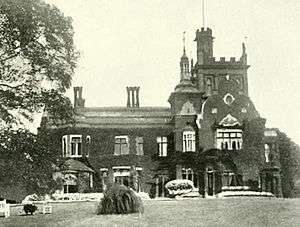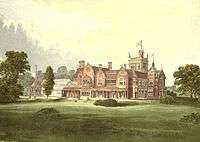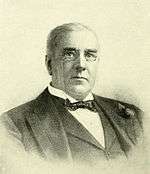Athlone House

Athlone House in Highgate, London, England, is an ornate large house in large gardens for industrialist owners from 1870 and 1940. In this time it was in the former county of Middlesex. It is in a state of disrepair and is awaiting restoration by current owners. It was designed by Edward Salomons and John Philpot in an intricate style, particularly as to shape and brickwork, blending Dutch and classical civilisation influences. It lies on the northern edge of elevated Hampstead Heath, from which it can be seen.
Origine

Edward Brooke built the house in about 1872. Brooke was born in Manchester in 1832.[1] He married in 1857 Jane Emily Alston and had many children. He also owned Pabo Hall in Conwy, Wales which still has his portrait in the hallway.
The house he had built is chiefly a mixture of classical architecture and neo-Gothic crenular with a tall dutch gable making up the pinnacle of the façade in front of a multi-turretted tower and with long, narrow Tudor-style chimneys on the left wing. A variety of stone and brick materials is therefore used in appropriate sections and the building can be compared to the generally smaller follies of the time.
In 1869 Brooke came from Manchester to London and bought Lord Dufferin’s estate at Highgate. Shortly after, he built Caen Wood Towers on this property.[2] In 1877 his wife Jane died and in the following year he married Frances Amyand Bellairs, daughter of the Reverend Henry Walford Bellairs.[3] He was a partner in the firm of Brooke, Simpson and Spiller who were aniline dye manufacturers in London.
Edward Brooke became Justice of the Peace for the County of Middlesex, for the City of London and for the County of Carnarvon. He was also one of Her Majesty’s Commissioners for the Lieutenancy of the City of London.[2] In 1880 the book entitled “A series of picturesque views of seats of the noblemen and gentlemen of Great Britain and Ireland” included a coloured engraving of Caen Wood Towers and a descriptive article about Edward Brooke and the house.[4] The coloured engraving is shown on the right and a link to the article is in the reference below.
Brooke left Caen Wood Towers in about 1885 and Francis Reckitt and his family came to live in the house.[5]
Francis Reckitt

Francis Reckitt, was a partner in the famous company of Reckitt and Sons. His father Isaac had founded the firm and he and his brother Sir James Reckitt were very prominent Directors at the time he resided at Caen Wood Towers.
Francis was born in 1827 in Lincolnshire, England. He lived for some years in Hull where the Reckitt and Sons company was based and later moved to Hessle. He was twice widowed and had numerous children before he married Eliza Louisa Whitlock in 1877.[6] The 1891 Census shows the family living at Caen Wood Towers and at this time there were four children still living with them. One of them was his son Francis William Reckitt who was an artist.[7]
Francis Reckitt became very wealthy and donated a great deal of money to establish public institutions. For example, in 1897 he paid for the Newland Homes Francis Reckitt House which was for infants.[8] He also provided the funds for the establishment of a new reference library within an existing library in Hull in 1890.[9] The Reckitt Convalescent Home (now demolished) was built in 1907 with money donated by Francis.[10]
Francis left Caen Wood Towers in about 1900 and Sir Cory Francis Cory-Wright became the owner of the house.
Sir Francis Cory-Wright


Sir Francis Cory-Wright was Chief of the large coal distribution firm called William Cory and Sons. He was considered to be one of the best known commercial men in the City of London and a chapter was written about him in the book entitled “London Leaders” in 1907.[11]
Sir Francis was born in 1839. His father was Lieutenant William Wright of the Rifle Brigade. He was educated privately and entered the firm of William Cory and Sons at the age of 21. He became Chief of the company in 1888 and was credited with the large development of this firm which occurred after his appointment.
In 1868 he married Mima Owen who was the youngest daughter of Sir Hugh Owen. The couple had two sons and three daughters. Sir Francis was very interested in local affairs particularly in the Highgate region. He led the movement to save for public use the area then known as Churchyard Bottom but is now known as Queen's Wood[12]
Sir Francis died at Caen Wood Towers in 1909. His widow remained at the house until 1911 when it was sold to Thomas Frame Thompson.[13] Unfortunately only two years later Thomas was killed in a shooting accident. The property was then sold in 1914 to Charles Henry Watson who also owned a home called Ashmount in Hampstead. In 1919 he sold Caen Wood Towers to Sir Robert Waley Cohen.[14]
Sir Robert Waley Cohen

Sir Robert Waley Cohen was the Managing Director of the Shell Company. He was the longest and most prominent resident of Caen Wood Towers. He lived there for over twenty years between 1919 and 1942.
Robert Waley Cohen was born in London in 1877. His father was Nathaniel Louis Cohen and his mother was Julia Waley, daughter of Jacob Waley, Professor at University College, London. After Robert left Cambridge University he entered the Shell Company and was progressively promoted until he became the Managing Director.[15]
In 1904 he married Alice Violet Beddington and the couple had two sons and a daughter. While they resided at Caen Wood they held numerous social events at the house and Lady Waley Cohen often allowed the gardens to be used for fetes and parties for girls clubs, Boy Scouts and to raise money for the less fortunate.[16]
Lady Waley Cohen died in 1935 but Sir Robert continued to live at Caen Wood Towers until about 1942 when it was taken over by the RAF.
Royal Air Force Station Highgate
In September 1942, the house was acquired by the Air Ministry. The RAF Intelligence School, formally housed in a number of nearby houses in Highgate, moved into Caen Wood Towers. The site was formally set up as Royal Air Force Station Highgate around grounds and outbuildings of the Caen Wood estate. This included accommodation, messing, equipment stores and a medical centre. Because of the sensitivity of intelligence and covert operations during the war, the site was not made fully public and it operated under the guise of an RAF convalescence hospital. A number of different courses were run lasting between 3 weeks and 5 days, teaching Air Intelligence, Escape and Evasion, and Basic Intelligence Analysis for direct entrants to intelligence work. The majority of the instruction was given by visiting specialists (from Air Ministry, MI-6, MI-9, Central Interpretation Unit Medmenham and Station "X" at Bletchley Park.)[17]
During World War 2, over 6000 Officers of the British Services (including dominion and Allied Forces attached to the RAF) attended intelligence training courses at the house. A description of the training given during the war at the house is contained in the book “Shot Down and on the Run” and an online link to this part of the book is given in the reference below.[18]
In late 1944, the school was hit twice by German V-1 flying bombs causing damage to the buildings and injuring a number of staff.[10]
Following the end of the war, training continued at RAF Highgate until 1948 when the Air Ministry decided that the School should move to the Air Ministry building as they were de-requisitioning the property. RAF Highgate (Caen Wood Towers) was handed over to the Ministry of Health in 1951 and its previous role remained an Official Secret until 2005 when files (such as the Units Form 540) were declassifed and made available to the public in the National Archives.[19]
The site was acquired by the Ministry of Health in 1951, and converted into a convalescent home specialising in geriatric care attached to the Middlesex Hospital and renamed Athlone House in 1955.[10]
The hospital was closed in 2003, and the site was sold to Dwyer Investments. The wing added in the 1940s and a further 1970s extension were demolished, and three new blocks of luxury apartments raised up in their stead, called Kenwood Place. The original house was sold on in 2006 to a Kuwaiti businessman, the Kharafi family for a reported £16 million.[10] Planning permission to build a new house on the site was refused by Camden Council in 2010, and the refusal upheld by the Planning Inspectorate in 2011.[20] In 2014 developers Athlone House Limited again appealed the decision to the Planning Inspectorate, but this was rejected in June 2015[21] after objections from The Highgate Society, who raised a 5000 signature petition to preserve the house.[22]
In January 2016, The Evening Standard reported that the house had been sold for about £20 million and that the new owners have contacted Camden Council "to discuss refurbishment plans", which are thought to keep the original house and build flats in the large gardens.[23]
In April 2016, it was reported in The Sunday Times that the Russian oligarch Mikhail Fridman had purchased Athlone House for £65 million.[24]
See also
- Beechwood House, borders Athlone House to the east
- Kenwood House, to the west.
References
| Wikimedia Commons has media related to Athlone House (formerly Caen Wood Towers). |
- ↑ England Census of 1861
- 1 2 North Wales Chronicle (Bangor), 18 October 1890, Issue 3280
- ↑ The Standard (London) December 24, 1877, p. 1
- ↑ "A series of picturesque views of seats of the noblemen and gentlemen of Great Britain and Ireland". p. 32.
- ↑ UK Census of 1891
- ↑ United Kingdom Births Deaths and Marriages
- ↑ "Francis William Reckitt looking over Dunster Village, Somerset". Francis Frith.
- ↑ "Newland Homes Francis Reckitt House". British Listed Buildings.
- ↑ The Yorkshire Herald, and The York Herald, November 05, 1890; pg. 5;
- 1 2 3 4 "Royal Northern Hospital". Lost hospitals of London. Retrieved 7 November 2015.
- ↑ "London Leaders: Historic Families, Ancestral Estates". 1907.
- ↑ Obituary of Sir Francis Cory-Wright, The Times (London) May 31, 1909; pg. 9
- ↑ "Ancient Country House sold". L'abeille de la Nouvelle-Orleans. 6 April 1911. Retrieved 7 November 2015.
- ↑ The Times (London), October 09, 1919; pg. 13
- ↑ The Times (London), November 29, 1952; pg. 8
- ↑ The Times (London), January 25, 1935; pg. 16;
- ↑ "How Athlone helped Defeat Hitler". The Camden New Journal. 25 June 2009. Retrieved 7 November 2015.
- ↑ Pitchfork, G (2003). Shot Down and on the Run. p. 18.
- ↑ "RAF Intelligence School". National Archives.
- ↑ Athlone House decision, The Planning Inspectorate, 21 April 2011.
- ↑ Plans for £80m London mega-mansion rejected after six-year battle, The Guardian, June 08, 2015.
- ↑ Objection letter, The Highgate Society, January 2014.
- ↑ Alexander, Stian. "Billionaires sell mock-Elizabethan mansion after losing planning war". The Evening Standard. Retrieved 20 January 2016.
- ↑ http://www.thesundaytimes.co.uk/sto/business/article1687952.ece
External links
- Photographs outside and inside Athlone House, 2009 (Highgate Society)
- Painting of the conservatory, 1944, by Kyffin Williams
Coordinates: 51°34′17″N 0°09′32″W / 51.5714°N 0.1589°W